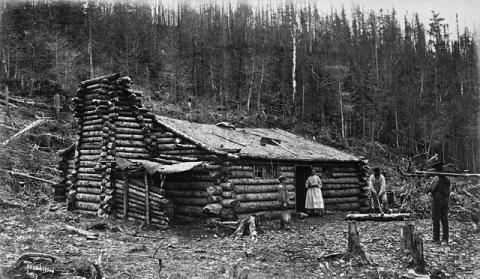
(Photo Credit: Alexander Henderson / Library and Archives Canada / PA-149763)
When imagining what life might have been like on Manitoulin Island in 1877, I found it helpful to surround myself with photographs that dated roughly to that era, some of which were taken on the island, but most of which were discovered in books or archives dedicated to preserving images from mid-to-late 19th century rural Ontario.
What I really wanted most were photographs of the Amer and Bryan families that dated to the 1870s (or a decade on either side) but those were not to be found. Instead I surrounded myself with reasonable substitutes that depicted clothing, hair styles, kitchen gardens, horse-drawn farm machinery, bottles and jugs, butter churns, grain grinders, grist mills, barns, steamboats, wagons, and much more. Anything, really, that gave me a sense of place and time.
An excellent source for these kinds of images is the photographic collection at Library & Archives Canada. The photo at the top of this page was found there and it served as the visual template for what I imagined the Bryan homestead would have looked like around the time of the murders. This particular photo dates to 1872, the year before the Bryans arrived on Manitoulin Island, but the roughshod appearance of the cabin brought to mind the sort of structure an early settler might have slapped together upon arrival with the intention of upgrading to a more permanent home once the land had been cleared, the crops were in the ground, and immediate threats to survival had been brought under control.
There are things in this photo that fire my imagination. The cabin, for instance, with its dilapidated roof, rough-hewn logs and insufficient window speaks volumes. So do the stumps and debris surrounding it, which were no doubt created by the homesteaders hastily clearing enough land to construct a home and provide much needed fuel for heating, cooking and other domestic needs. Presumably more land has been cleared beyond the gaze of this photograph, land on which crops were grown, livestock was pastured, and a kitchen garden valiantly fought for survival.
It must've been incredibly dark inside this cabin, not to mention cramped and claustrophobic. The roof would surely have leaked and the floor was likely made of compacted dirt. It's not hard to imagine that rodents, mosquitoes, and biting flies made comfort a challenge nor would it be a surprise to discover that this home was one of the countless that burned to the ground due to domestic accidents. It's the chimney that makes me think this. It certainly looks dangerous enough to take down a home with or without the assistance of an overheated wood stove or an overturned candle.
I'm further intrigued by the woman standing in the doorway wearing an apron over her full Victorian skirt in an effort to keep it free of grime as she toiled in the cabin cooking and cleaning and baking while the men laboured outdoors where there was no end to wood that needed chopping, stumps that needed pulling, crops that needed tending, and livestock that needed feeding.